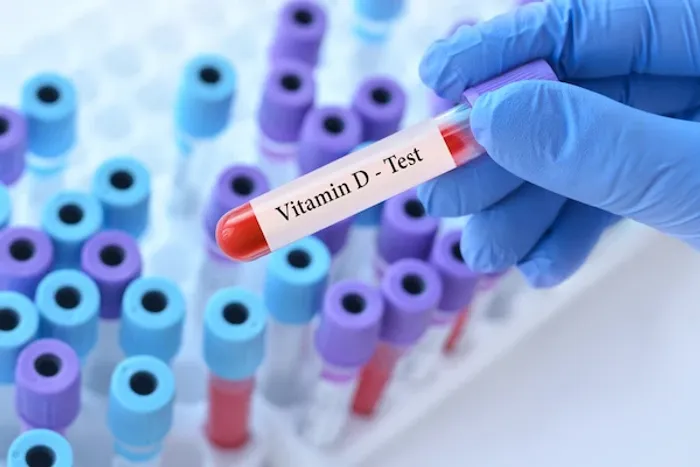Guide to Vitamin D Test
Wondering about a Vitamin D test? Learn why you might need one, what to expect during the procedure, and how to interpret your results in this comprehensive guide.

Written by Dr. Dhankecha Mayank Dineshbhai
Reviewed by Dr. Rohinipriyanka Pondugula MBBS
Last updated on 11th Sep, 2025

Your Complete Guide to the Vitamin D Test: Why, When, and How
Introduction
Have you been feeling unusually tired, achy, or a bit down, especially during the winter months? You're not alone. Millions of people worldwide are deficient in vitamin D, the essential "sunshine vitamin" crucial for strong bones, a robust immune system, and overall wellbeing. But how do you know if your levels are low? The answer lies in a simple vitamin D test. This comprehensive guide will illuminate everything you need to know about this common blood test. We'll explore who should get tested, what the procedure involves, how to interpret your results, and what steps to take next to optimize your health. Understanding your vitamin status is a powerful step toward taking control of your vitality.
What is a Vitamin D Test, Exactly?
A vitamin D test is a blood test that measures the concentration of vitamin D in your body. Unlike most vitamins, vitamin D functions like a hormone, and its levels need to be within a specific range for your body to perform optimally. It's not about checking for a single vitamin but assessing a key regulator of calcium metabolism, bone health, and immune function. The test itself is a straightforward blood draw, similar to a standard cholesterol or blood sugar check.
Most people are unaware of their vitamin D status until symptoms appear or a doctor recommends screening. Since deficiency is often "silent," the test serves as a critical diagnostic tool to identify a problem before it leads to more serious health issues like osteoporosis.
The Two Main Types of Vitamin D Tests
There are two primary forms of vitamin D tested in the blood:
1. 25hydroxyvitamin D [25(OH)D]: This is the major form of vitamin D circulating in your blood. It's created when vitamin D from sun exposure, food, or supplements is processed by your liver. It's the best indicator of your overall vitamin D status.
2. 25dihydroxyvitamin D [1,25(OH)2D]: This is the active, hormone form of vitamin D, produced primarily by your kidneys. Doctors rarely order this test unless they are investigating certain kidney diseases or abnormal calcium levels.
Consult a General Physician for the best advice
Why the 25Hydroxy Test is the Gold Standard?
The 25hydroxy vitamin D test is considered the gold standard and most commonly ordered test because it accurately reflects your body's vitamin D stores. It has a longer halflife (lasting several weeks in the blood), making it a stable and reliable marker. The active form (1,25dihydroxy), in contrast, has a short halflife of only a few hours and its levels can be normal or even elevated in people with a true deficiency, as the body struggles to compensate. Therefore, for diagnosing a deficiency, the 25hydroxy test is unequivocally the right choice.
Why Would You Need a Vitamin D Blood Test?
You might need a vitamin D test for several reasons, ranging from experiencing specific symptoms to having known risk factors. A doctor may order it as part of a routine checkup or to investigate an underlying issue.
Common Signs and Symptoms of Vitamin D Deficiency
Low vitamin D can manifest in various ways, including:
- Persistent fatigue and tiredness
- Bone pain and back pain
- Frequent illnesses or infections (due to a weakened immune system)
- Depression or low mood
- Impaired wound healing
- Hair loss
- Muscle pain and weakness
If you are experiencing a cluster of these symptoms of vitamin D deficiency, it is a strong signal to speak with your doctor and consider getting tested.
Key Risk Factors for Low Vitamin D Levels
Even without obvious symptoms, you may be at higher risk and a good candidate for screening. Key risk factors include:
- Limited sun exposure: Living in northern latitudes, being homebound, wearing full body coverings, or consistently using sunscreen.
- Darker skin: Higher melanin reduces the skin's ability to produce vitamin D from sunlight.
- Age over 65: The skin's efficiency at producing vitamin D decreases with age.
- Obesity: Vitamin D is fat soluble and can become sequestered in body fat, reducing its availability in the blood.
- Digestive conditions: Crohn's disease, celiac disease, and other conditions that cause fat malabsorption can lead to deficiency.
- Having had gastric bypass surgery.
- Exclusively breastfed infants, as human milk is not a rich source of vitamin D.
Monitoring for Toxicity: Can You Have Too Much?
While rare, it is possible to have excessively high levels of vitamin D, known as toxicity or hypervitaminosis D. This is almost always caused by taking extremely high doses of supplements for a prolonged period, not from diet or sun exposure. Toxicity can cause nausea, vomiting, weakness, and serious complications like kidney stones and damage due to high calcium levels. A doctor may order a vitamin D test to monitor your levels if you are on high-dose prescription supplementation.
How to Prepare for and Take a Vitamin D Test?
Getting a vitamin D test is a simple process with minimal preparation required.
Do You Need to Fast? PreTest Instructions
- Typically, fasting is not required for a standard 25hydroxy vitamin D test. You can usually eat and drink normally beforehand. However, it's always best to follow the specific instructions given by your healthcare provider or the testing lab, as sometimes the test is ordered as part of a larger panel that may require fasting.
The Blood Draw Process: What to Expect?
The test is performed by a phlebotomist at a clinic or lab. The process is quick:
1. An elastic band (tourniquet) is tied around your upper arm to make veins more visible.
2. The site (usually inside of the elbow) is cleaned with an antiseptic wipe.
3. A small needle is inserted into a vein to collect a blood sample into a vial.
4. The needle is removed, and pressure is applied with a cotton ball to stop any bleeding. A small bandage is then applied.
The entire procedure usually takes less than five minutes. For those uncomfortable with needles, Apollo24|7 offers convenient home collection for tests like vitamin D, where a trained professional can collect the sample from your home.
Understanding Your Vitamin D Test Results
This is the most critical part. Your results will show a number and a unit of measurement, which must be interpreted correctly.
Decoding ng/mL vs. nmol/L: Units of Measurement
You will see your result in one of two units:
- nanograms per milliliter (ng/mL) commonly used in the US.
- nanomoles per liter (nmol/L) commonly used outside the US.
- To convert: nmol/L = ng/mL × 2.5. Always check which unit your report is using to avoid confusion.
Vitamin D Levels Chart: Deficient, Insufficient, Sufficient, and Toxic
While interpretations can vary slightly between laboratories and medical societies, the following ranges from the Endocrine Society are widely referenced:
What Your Specific Results Mean for You?
- Deficient/Insufficient: This indicates a need to raise your levels. Your doctor will likely recommend vitamin D supplementation. The dosage will depend on how low your levels are.
- Sufficient: This is the goal. If you are in this range, maintain your habits of sensible sun exposure, a balanced diet, and possibly a maintenance supplement if advised.
- Above Normal/Toxic: This requires immediate medical attention. You will need to stop all supplementation and may need treatment to manage high calcium levels.
It is essential to discuss your results with a healthcare professional who can interpret them in the context of your overall health. If your condition does not improve after trying these methods, book a physical visit to a doctor with Apollo24|7 for a personalized treatment plan.
Beyond the Test: Addressing Your Vitamin D Levels
A test is only valuable if it leads to action.
- Treatment for Deficiency: Supplements, Diet, and Sunlight
- Supplements: Vitamin D3 (cholecalciferol) is the preferred form for supplementation. Doctors often prescribe a high weekly dose for 812 weeks for deficiency, followed by a maintenance dose.
- Diet: Incorporate fatty fish (salmon, mackerel), fortified dairy and plant milks, egg yolks, and beef liver.
- Sunlight: Aim for 1030 minutes of midday sun exposure several times a week, without sunscreen, depending on your skin sensitivity.
How Often Should You Retest Your Vitamin D?
If you are being treated for a deficiency, your doctor will typically recommend a retest after 3-4 months to see if the supplementation has been effective. Once your levels are optimal, an annual test may be sufficient for monitoring, especially if you have ongoing risk factors.
Conclusion
Understanding your vitamin D status through a simple blood test is a proactive and powerful step toward safeguarding your long-term health. From supporting strong bones to bolstering your immune system, maintaining sufficient levels of this essential nutrient is crucial. Whether you're experiencing symptoms or simply have known risk factors, this guide empowers you to have an informed conversation with your healthcare provider. Don't guess about your health—know your levels. If your test results indicate a deficiency or you have ongoing health concerns, remember that professional guidance is key. Consult a doctor online with Apollo24|7 for further evaluation and a tailored plan to help you get back to optimal health and vitality.
Consult a General Physician for the best advice
Consult a General Physician for the best advice

Dr. M L Ezhilarasan
General Practitioner
6 Years • MBBS
Visakhapatnam
Apollo 24|7 Clinic - Andhra Pradesh, Visakhapatnam

Dr D M Karthik
General Practitioner
4 Years • MBBS, Fellowship in Diabetes Mellitus, Advance certificate in Diabetes Mellitus, Derma Nutrition Certification
Visakhapatnam
Apollo 24|7 Clinic - Andhra Pradesh, Visakhapatnam

Dr. Mohammed Kamran
General Practitioner
5 Years • MBBS, FIDM
Nashik
Apollo 24|7 Clinic - Maharashtra, Nashik

Dr. Jawwad Mohammed Kaleem
General Practitioner
4 Years • MBBS
Hyderabad
Apollo 24|7 Clinic, Hyderabad

Dr. Chaithra H
General Physician/ Internal Medicine Specialist
6 Years • MBBS, MD General Medicine, DNB General Medicine
Bangalore
Apollo 24|7 Clinic - Karnataka, Bangalore
Consult a General Physician for the best advice

Dr. M L Ezhilarasan
General Practitioner
6 Years • MBBS
Visakhapatnam
Apollo 24|7 Clinic - Andhra Pradesh, Visakhapatnam

Dr D M Karthik
General Practitioner
4 Years • MBBS, Fellowship in Diabetes Mellitus, Advance certificate in Diabetes Mellitus, Derma Nutrition Certification
Visakhapatnam
Apollo 24|7 Clinic - Andhra Pradesh, Visakhapatnam

Dr. Mohammed Kamran
General Practitioner
5 Years • MBBS, FIDM
Nashik
Apollo 24|7 Clinic - Maharashtra, Nashik

Dr. Jawwad Mohammed Kaleem
General Practitioner
4 Years • MBBS
Hyderabad
Apollo 24|7 Clinic, Hyderabad

Dr. Chaithra H
General Physician/ Internal Medicine Specialist
6 Years • MBBS, MD General Medicine, DNB General Medicine
Bangalore
Apollo 24|7 Clinic - Karnataka, Bangalore
Frequently Asked Questions
What is the cost of a vitamin D test?
The cost can vary widely depending on your location, healthcare provider, and insurance coverage. Without insurance, it can range from a few hundred to a couple of thousand rupees. Checking with your insurance provider or using a service like Apollo24|7 can provide a clear estimate.
Can I test my vitamin D levels at home?
Yes, several companies offer athome test kits. These typically involve a fingerprick blood sample that you mail to a lab for analysis. While convenient, it's important to choose a reputable company and discuss the results with a doctor for clinical context.
What is the optimal vitamin D level for women?
The general optimal range (30100 ng/mL) applies to both men and women. However, vitamin D is especially critical for women's bone health to prevent osteoporosis later in life. Pregnant women should also pay close attention to their levels.
How long does it take to correct a vitamin D deficiency?
With appropriate supplementation prescribed by a doctor, it typically takes several weeks to a few months to raise your levels from deficient to sufficient. A follow-up test is crucial to confirm improvement.
Do I need a doctor's prescription to get a vitamin D test?
In many places, you can order a vitamin D test directly from a lab without a doctor's order (direct access testing). However, having a doctor involved is highly recommended to ensure the test is appropriate and to correctly interpret the results to create a treatment plan.


